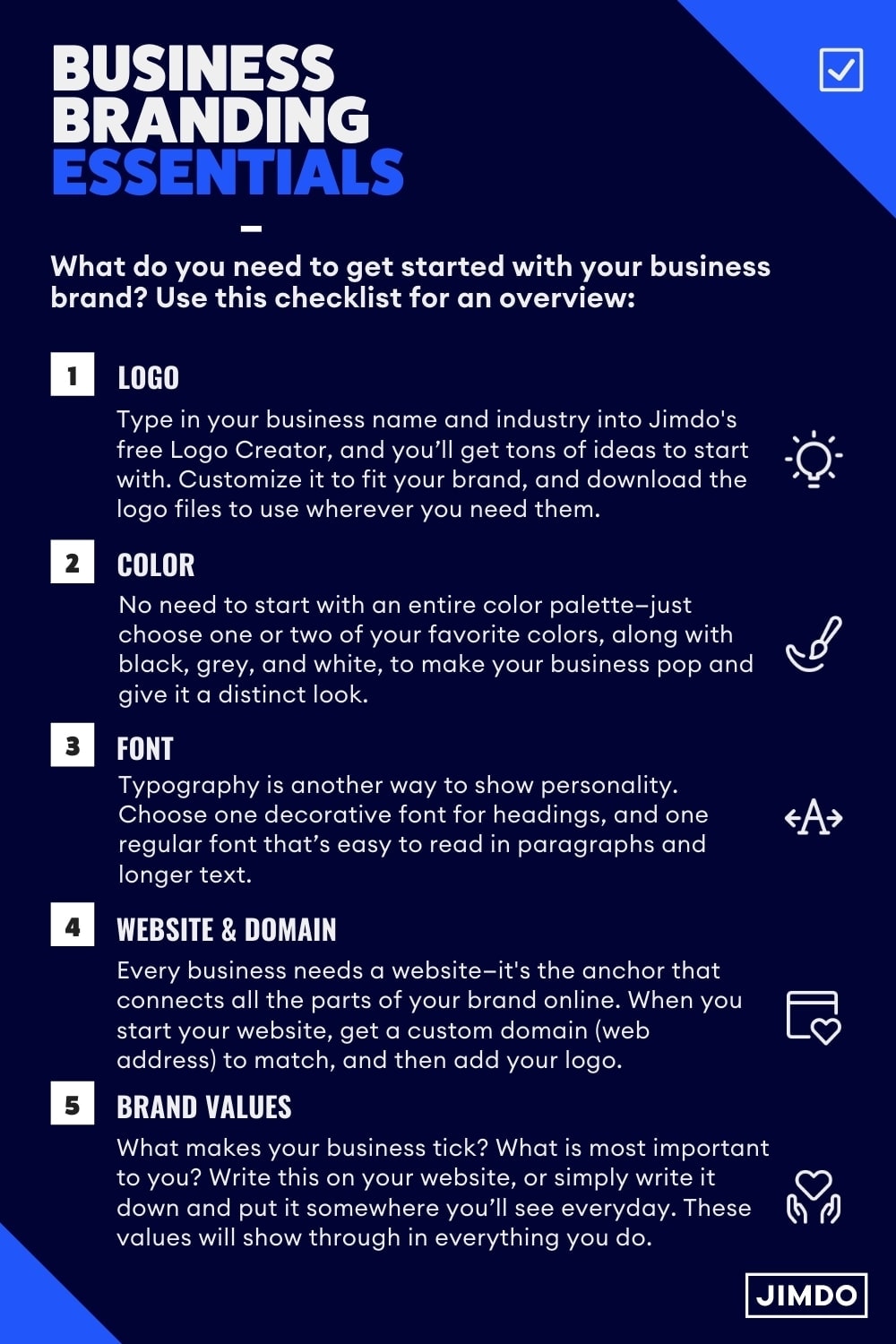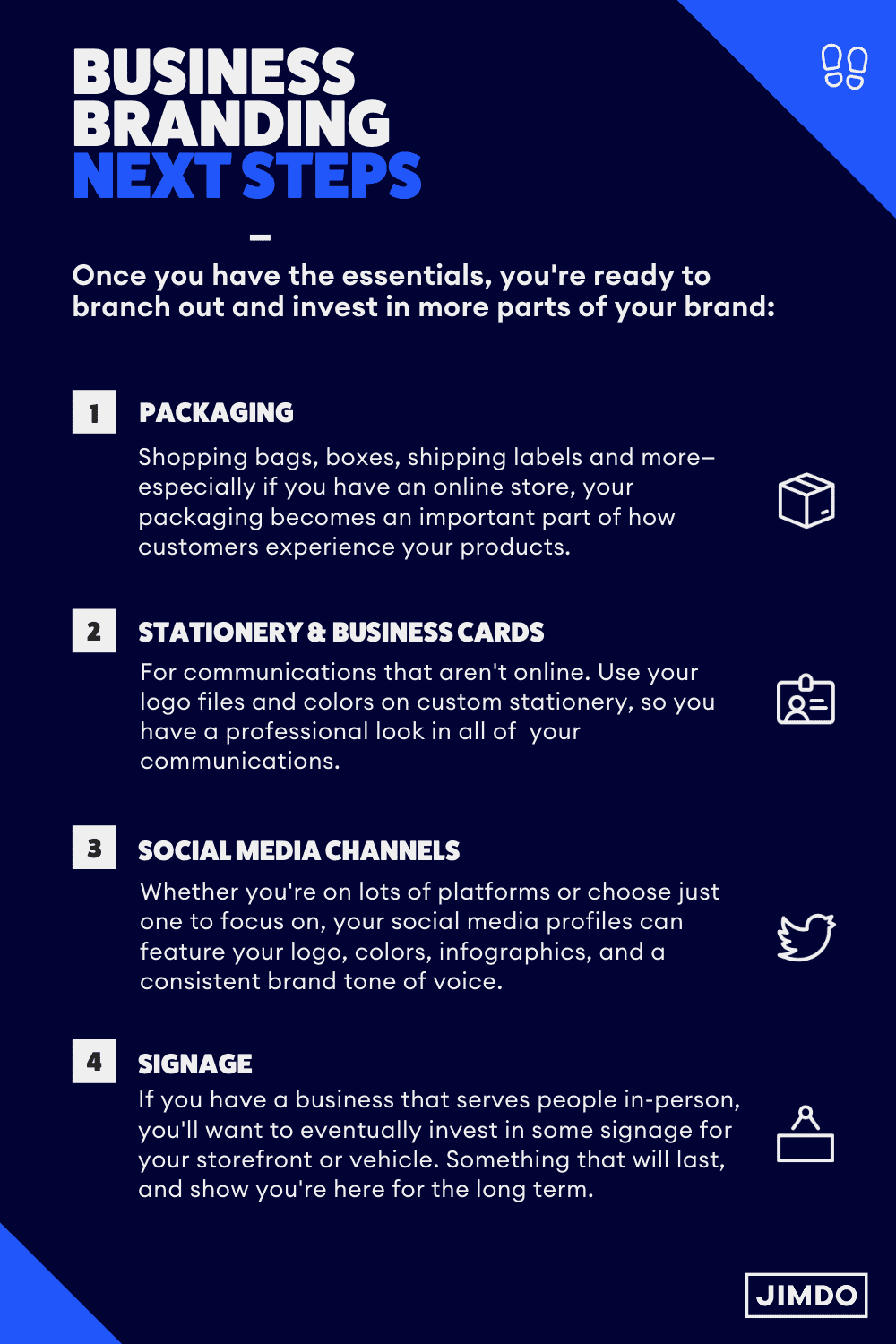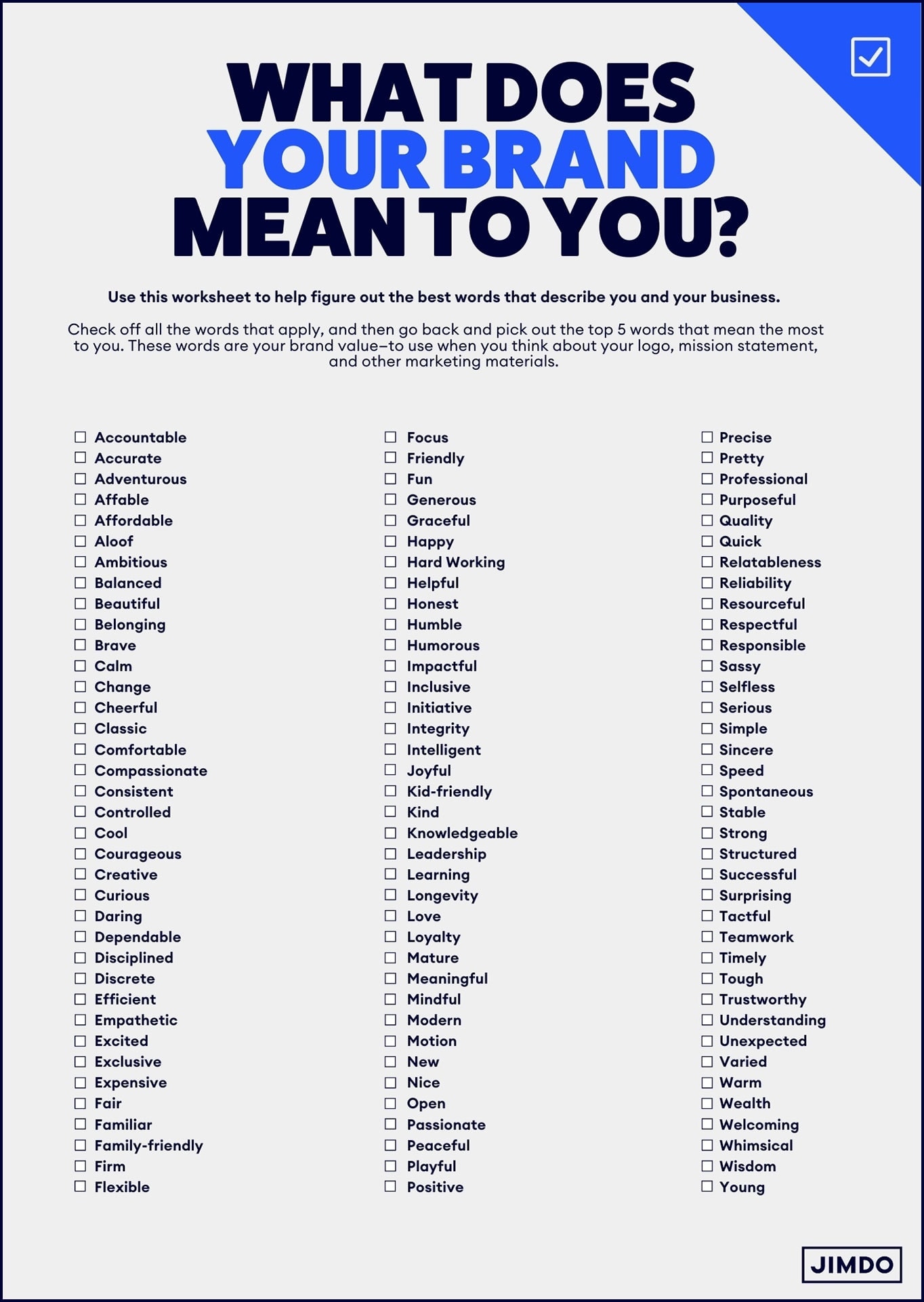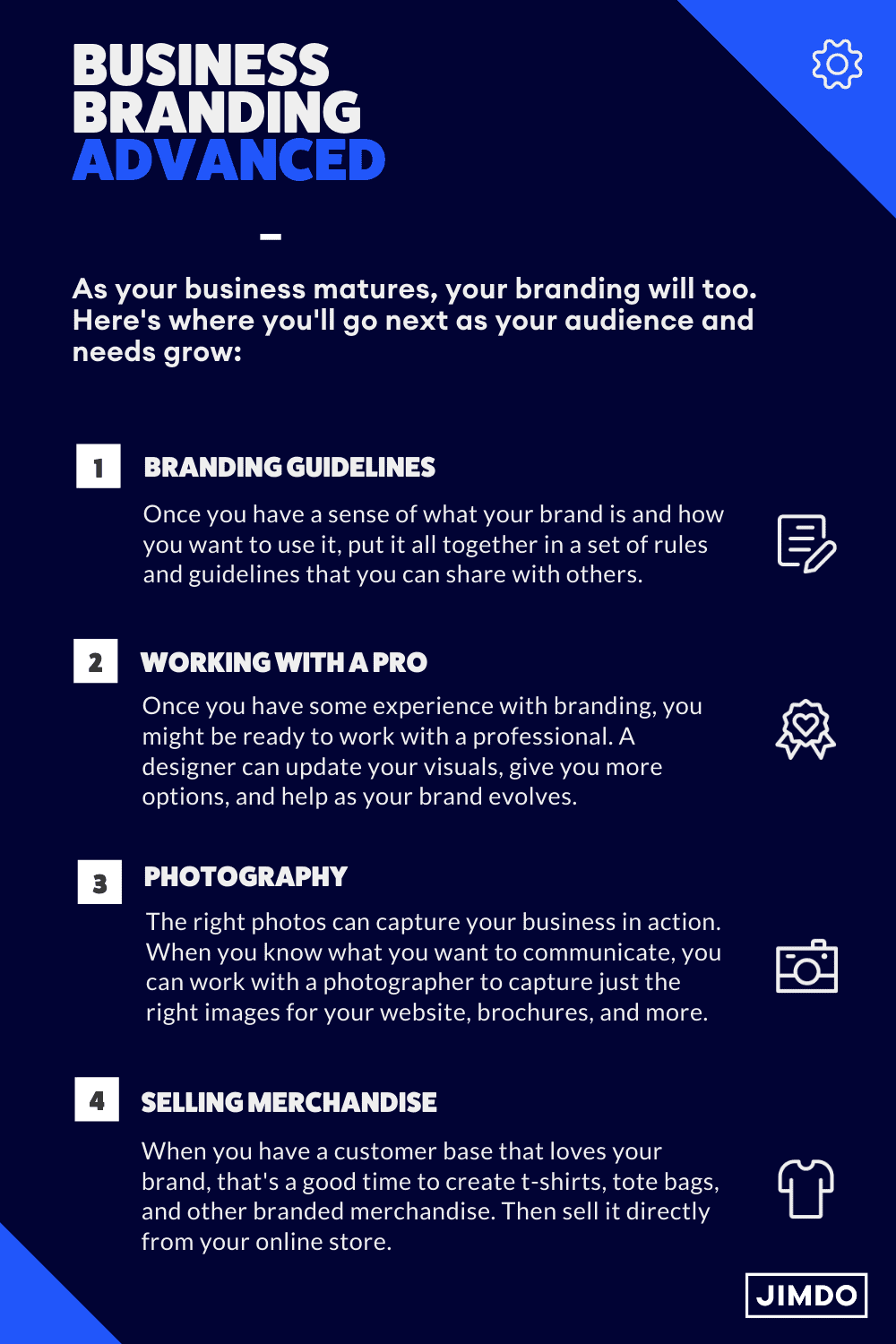Most articles on branding start by talking about billion-dollar brands and logos known around the world. But that doesn’t mean branding is reserved for big companies, celebrities, and “influencers.” If you run your own business or are self-employed, you can create a successful business brand too. In fact, branding is one of the best things you can do to market your business.
In this guide, we’ll take some of the mystery out of branding, and help you figure out what your brand already is, and how to communicate it online to your customers.
Do I need a business brand?
The important thing to remember about your business brand is this: you probably already have one.
The way you work, the products you make, the stuff you like to do, and of course your own personal style—all of those define your brand. You don’t have to create something from scratch.
The process of branding is simply figuring out what those traits are, and coming up with creative ways to tell people about it. It’s a task that can be fun, simple, and inexpensive.

What is branding, anyway?
From cave paintings to family crests, people throughout history have always wanted to leave their mark. But today, “branding” is more than just having a monogram or a logo. It’s a way to quickly communicate what your business is all about. What you do, how expensive you are, who your target audience is, and what qualities you’re known for. All of that (and more) can be conveyed by branding.
For a person, you’d describe this as their personality, character, and style. For a business, you’d describe this as their brand.
If you think of a brand as the personality, character, and style of your business, branding is what you do to communicate that to your customers.
Branding includes everything from having a professional logo and consistent packaging, to the specific values that customers know they can count on you for.
Why is branding important for a small business?
Why even bother with a brand? Why not just tell people “We’re a store that specializes in affordable and fun kids toys, come on in!”
1. Brands communicate on an emotional level
You can describe your business logically and rationally, but a good brand triggers people’s emotions in a positive way. Subconsciously, they feel connected and attached to your business, without having to think about it too much.
2. Brands travel faster than words
Humans process visual information faster than any other kind. A customer can learn a huge amount about your business (and form an opinion about it) in the blink of an eye. If you have a strong, positive brand for your business that communicates the right message, this split-second thinking works to your advantage.

3. Branding makes your business feel familiar, even to new customers
You’ll hear a lot of advice out there that your brand will help you stand out from the crowd. But a major part of branding is helping you fit in to customers’ existing expectations. You can use your business brand to create the “right” look for your target audience, one that signals to new customers, “Hey, you’re in the right place.”
4. Brand loyalty is a powerful force
People are hard-wired to feel very attached to brands, very quickly. The Harvard Business Review sums up how most consumers think:
“In a choice between a known quantity and an unknown quantity, I’ll take the one I know, even if there’s something wrong with it.”
This explains why people will keep buying the same product, even if there’s a better one available. It also makes it much harder to break into a market if you’re a new business. And once you do, you’ll need a strong brand to keep customers coming back.
5. Branding makes your business memorable and recognizable
We process visual and emotional information faster, and we remember it better too. A customer doesn’t have to remember your logo and brand identity exactly to remember the general idea—and recognize it when they see you again.
That’s why a clear brand makes it easier for customers to recommend you via word of mouth, which is still one of the most powerful marketing tools for small businesses and freelancers. If you’re memorable, they are more likely to tell friends and family about you: “Oh yeah, that’s the one! They’re great.”
6. Branding indicates professionalism and trust
A consistent brand, even a simple one, shows a level of professionalism and attention to detail that most customers appreciate. It sends a message that you’re serious about your business, you’ve invested in it, and that they can trust you to be there in the months and years ahead. And to be honest, it can make your business seem more established than it actually is.
7. A good brand helps you make decisions
One benefit of branding that people often overlook is how it helps you, the business owner, in your day-to-day work. Like a business plan, it provides a touchstone when you have to make tough decisions. “Is this on-brand for me?” “Is this what I want to stand for?” When you can stand by the elements and values of your brand, your path is clearer.

What is a brand identity?
Your brand identity is all the pieces that go into shaping your company’s image. Typically people think of this as their logo, colors, and fonts, and business name. But just like your personal identity is about more than what you wear, your brand identity is about more than just the designs. It also includes:
Tone of voice
How does your business communicate to customers? Are you chatty and casual? Serious? Calm? Formal? Friendly? Your business speaks in “one voice” that’s the same from one day to the next. We love things that are familiar, so using a consistent tone of voice helps customers feel comfortable around you and builds trust.
Brand promise
What can your customers expect you to deliver, every single time? Examples might be friendly customer service, high-quality products, discretion, creativity, timeliness, etc. A local carpentry company in my neighborhood is called “We Show Up”—a perfect example of a brand promise being right there in the company name.
Mission statement and values
Why do you do what you do? Probably not because it’s easy. There’s something you like about your work, something that makes you get out of bed in the morning. There’s a reason you’ve decided to take the road less traveled and run your own business. Are there things that are important to you? “I would never do this” or “It’s important for me that my work has this.” Those are your values, and your mission statement stems from that.
One example is the outerwear company Patagonia. Patagonia has built an entire brand around sustainability and care for the environment, The gear is expensive, but people buy it because they like and relate to the ethos for the company. Does this company believe in issues I support? Do we share values? Purchasing decisions are deeply connected to brands, especially for higher-end products.
Your story
Your story as a small business is one of the best ways to connect emotionally to your customers. Many people take pride in supporting small businesses and they can feel attached to you as a person, as well as a business. Your brand story is something you can communicate on your website’s About Page, your product descriptions, and more.
How do you define your brand?
Like we mentioned before, your business brand likely already exists in some form. You just need to spell it out a little bit more. So before you get into colors and typography, take a few minutes to think about your brand personality. By answering some of these questions, you’ll have a better sense of the direction you want to go.
- What are you already known for, and what do you want to be known for?
- How do you want customers to describe you? Imagine what a delighted customer might say about you when you’re not in the room. Examples might be kind, supportive, quick, precise, experienced, motivating, flexible, efficient, understanding, safety conscious, reliable, entertaining, etc.
- What kind of customers do you want to attract? If your target audience is retirees looking to relocate, the way you express yourself will be different to a business that sells children’s fiction.

Do this activity yourself with our Jimdo Branding Worksheet
Branding FAQ
Is branding just for new businesses?
Not at all. Even if you’re an established business, you can still think about refreshing or reinventing your existing brand. Companies do it all the time! Maybe your logo is starting to look dated and you want a more modern look. Or maybe you’re starting to offer new services, or you’re looking to appeal to new types of customers. Tastes change and customers change, so you shouldn’t be afraid to try something new, as long as the values underneath stay true to you.
Why is having a logo important for a brand?
A logo is a starting point for many visual brands. It’s something you can use to mark all your communications, and it’s often the first piece of branding people will see associated with your business. For more about logos and how to develop your own, see our Logo Design Guide.
Is creating a brand expensive?
No, it doesn’t have to be. Some of the most important elements of your brand—your story, your mission, your values—cost nothing to create, just the time it takes to sit down and articulate them. When it comes to a visual brand, this doesn’t have to be expensive either. We recommend starting by creating a logo using a free logo creator. Start by using the same colors and typography across all of your materials. Down the road, you can always work with a professional designer when you’re ready to invest more money and have a stronger sense of what you want.
Does my brand need to follow the most recent trends?
No. Though you’ll probably see a lot of trendy brand designs shared on Pinterest, a strong brand should be timeless and classic. Most importantly, it should fit your target audience and make them feel included and welcome. That’s one reason why a trendy brand can backfire if it doesn’t stay true to your customers and represent them. And of course, many successful brands use vintage or retro elements.
Do I have to work with a professional designer or branding agency?
Not at the beginning. Working with a graphic designer or a brand consultant can be a really fun, rewarding experience when you’re ready. A seasoned professional will walk you through the process and help you develop something truly unique. On the flip side, the process takes more time and is more expensive. If you’re not sure what you want, or you don’t have the budget yet, there are lots of other tools out there that can get you started.

Small business branding checklist
The Essentials
- Logo. Start with the free Logo Creator. Type in your business name and industry, and you’ll get tons of ideas to start with. When you have one you like, you can download the logo files and use it on your website and other materials.
- Colors. You don’t need a complicated color palette yet. Just using one or two distinct colors, along with black, white, or grey, can still create a strong look. Read more about colors and how to match your favorite color on your website.
- Fonts. People usually choose one decorative font for headings, and one regular font that’s easy to read for their paragraphs and longer text. Read more about choosing fonts.
- Website & domain. Your business website is an essential piece of your brand. Even if you already have social media accounts, a website is the anchor that connects it all together—your visuals and your story. When you start a website, you can get a custom domain (web address) to match, and then make a business card for your business.
- Values and brand promise. Even if you’re not ready to publish these publicly, you should know deep down what these are. They’ll provide a touchstone for everything else you do and help you make the right decisions for your business. It can be as brief as 1-2 bullet points. Write them down and stick them somewhere you’ll see everyday, like by your workbench, desk, or light switch.
Branding Tip: To save money, start with a custom ink stamp or stickers with your logo on them. Then you can stick them to materials like shopping bags and mailing labels without paying a premium for custom-printed marketing materials before you’re ready.
What makes a good business brand?
The sign of a good brand for a small business is that it feels natural for you. Authentic. Something that’s easy for you to keep up with, easy to maintain, and easy to create.
Authentic
Consistent
Simple
If you have a logo that you love, it might be tempting to plaster it all over everything. This isn’t a good use of your resources. It’s better to focus on the consistency of a few key elements, and focus on keeping your brand promise so that customers know they can trust you. A flashy brand might bring them in the door, but if you don’t live up to the promise, they won’t return.
Remember, a brand can be communicated in a blink of an eye, but it’s also something you will build over time. It’s about the visuals, yes, but it’s also about the qualities that make your business special, and the parts of your work that are important to you. A sense of purpose and a sense of clarity, no matter what you do: that’s what will make your brand stand out.

